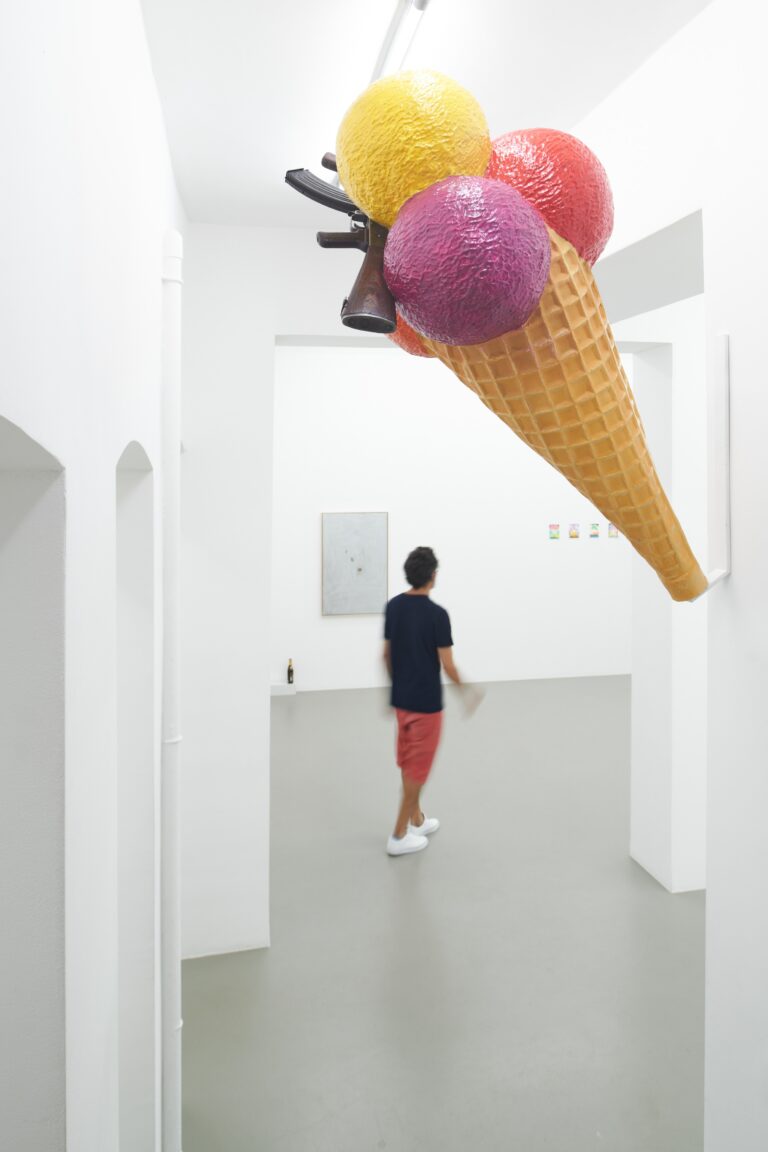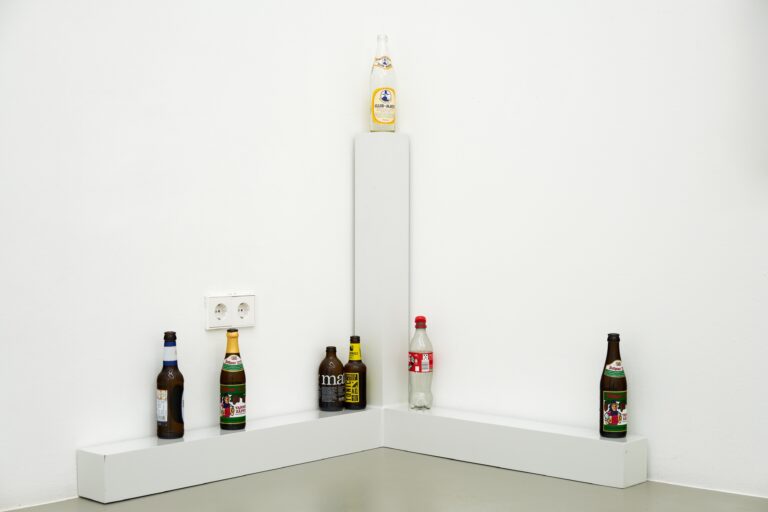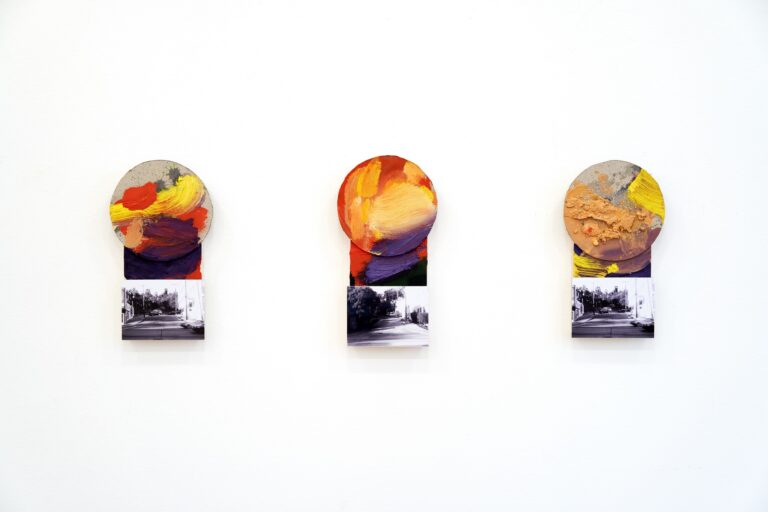Published on 15 JUL 2024
Jonathan Monk
Not A Cloud In The Sky (a summer group show)
5 JUL until 31 AUG
Free Association with a Conceptual Price Tag
In the mid-nineties, the cable television channel Cartoon Network ran an advert to promote its own programming that centred around the concept of an interconnected cartoon universe. In this short animation, the character Velma[1] was said to be the central point of the Cartoon Network cosmos and it referred to her as “a giant celestial body that is in some way linked to every toon alive”. The concept was simple, if you took any character from any Cartoon Network show, you would be able to trace a path from them back to Velma – a sort of 6-degrees-of-separation for cartoon characters.[2]
At the time, this Velma-centric view of the universe seemed unconvincing (to me at least). Why should the Cartoon Network’s network of cartoons be made up of inflexible linear connections leading to a single, static nucleus? Wouldn’t it make more sense for this network to resemble a criss-crossing 3D matrix, constantly in flux, with no fixed central point? It seemed more logical that it would look like a web with multiple paths – more akin to the internet than the wheel of a bicycle with radial spokes.
A similar 3D network in constant flux is how I imagine the mind of Jonathan Monk to be formed. Though instead of linking cartoon characters, this network is made up of art historical citations and pop-culture references, constantly expanding and contracting, bringing the likes of Salvo, Louise Lawler, The Smiths, Martin Kippenberger and The Simpsons into closer and further proximity. In doing so, this network creates unexpected and often outwardly unconventional connections – a kind of Freudian free association à la Jonathan Monk.
Drawing a parallel between Jonathan Monk’s mind and a fairly obscure advert for the Cartoon Network could seem an unusual way to start the text for the artist’s new exhibition Not A Cloud In The Sky (a summer group show) – and perhaps this fairly personal point of reference in a text dealing with ideas of free association is making things all a bit meta – but this concept of a fluctuating 3D network of touchpoints seems like an important idea to grasp both Monk’s work in general and the exhibition itself. After all, how does one get from a watercolour of a sunset to an AK-47 contained within a colourful ice cream if not through a criss-crossing web of intriguing and personal references? Or, to look at it another way, how does a series about Ed Ruscha turn into something that more resembles On Kawara?
In the late nineties, Jonathan Monk was living in Los Angeles. And it was during his time in the Golden State that he created his work None of the Buildings on Sunset Strip (1998/2021) – a typical Monk-esque homage to Ed Ruscha’s seminal photobook Every Building on the Sunset Strip (1966). While in the original Ruscha documented all of the buildings that lined a particular stretch of the Strip, Monk, using the same style of black-and-white photography, captured instead the gaps between the structures. In successive decades, Monk has returned to Ruscha and the Sunset Strip on a number of occasions, with each his subsequent reframing showing greater or lesser proximitiy to the original.
In his new exhibition, Monk exhibits a new series of sunset works. However, in this new body of work, any allusion to Ed Ruscha seems to have disappeared – there are no black-and-white images of buildings (or non-buildings) in Los Angeles. Instead, we are presented with watercolour scenes of the setting sun in vivid hues. Painted one per day, with the precise date of creation noted, this new body of work was begun by Monk while he was on holiday in Greece.
Vacations are periods of life where the regular boundaries of time become more fluid. And watching the sun set on holiday (possibly at a beachside taverna while enjoying a beer or Mastika) can become a check-point of sorts, an occasion to mark the passing of the day. Similarly, Monk’s sunsets, through the act of their ritualistic quotidian production, become records of time – far from being homages to Ed Ruscha, these new works seem to owe more to On Kawara. They could be seen as stylised “Date Paintings” that have done away with the ascetic nature of typography to present us with a more joyful and colourful reminder of the flow of time. However, if you look past On Kawara, along the fluctuating interconnected web of references in Monk’s mind, you might just catch a faint glimpse of an octogenarian American artist smiling back at you.
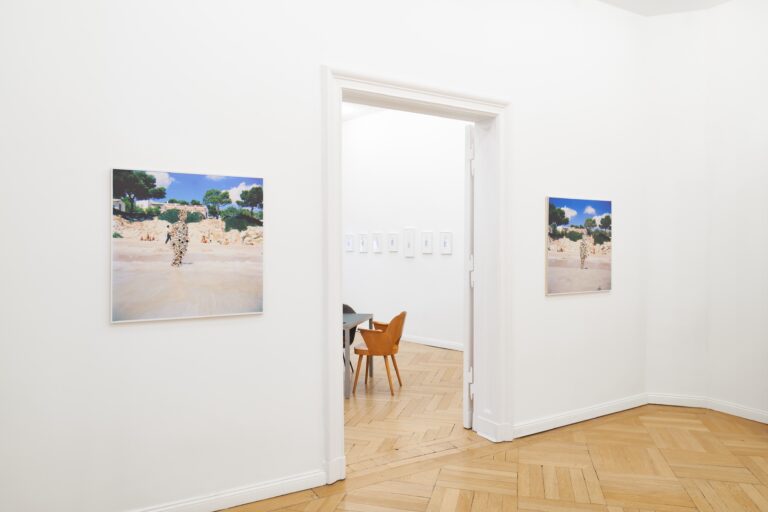
Jonathan Monk, Not A Cloud In The Sky (a summer group show), 2024, Installation views, Meyer Riegger, Berlin. Photos: Oliver Roura
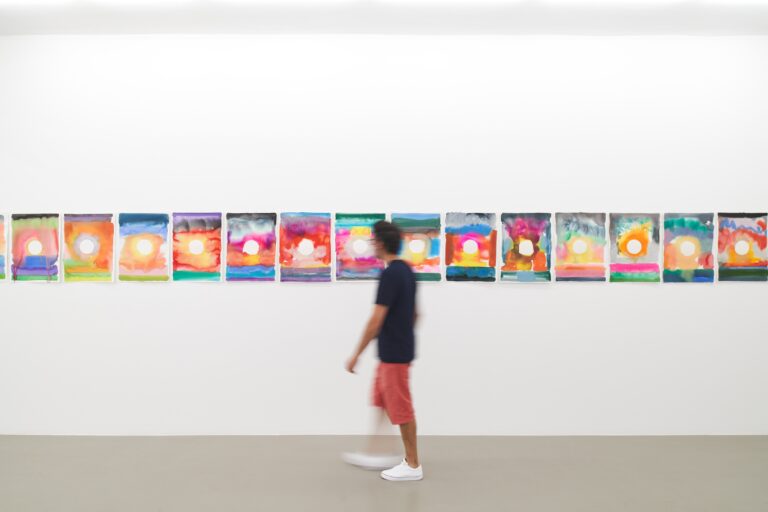
Jonathan Monk, Not A Cloud In The Sky (a summer group show), 2024, Installation views, Meyer Riegger, Berlin. Photos: Oliver Roura
The watercolour sunsets presented in this exhibition are complemented by works with more- and less-obvious connections to sunsets and summer holidays – some (Après Sun I–V) even employ the physical tools of a vacation. The show also includes one of Monk’s “Holiday Paintings”. This series of works, begun in 1992, sees the artist painstakingly recreate the hand-written offers for flights and package holidays that – back before we had taken to booking holidays online – could be found prominently displayed in the windows of travel agents. Monk then chose to sell the paintings at the price of the holiday advertised – a painting of a trip to Tenerife for £199, for instance, would cost precisely that much. In doing so, Monk offered people a choice.
These “Holiday Paintings” were in many ways the first outing of Monk’s “conceptual” pricing – something that has characterised his practice since. In these series, works are not necessarily priced according to conventional art-world metrics (size, material, etc), but instead follow other pricing rationales. His “Restaurant Drawings” are another example, where the price of the artwork corresponds to the price of the meal stated on the receipt, or his “Salvo” works, where the price is defined by the number of trees present in the work. While these works on one hand play with the often-opaque pricing strategies and value assumptions of contemporary art, there is without doubt also an element of attempting to democratise the art market and to allow for greater participation within it. So how much exactly is a sunset worth? Within the conceptual framework of this series: €1000.
And it is with these “€1000 Sunsets” and the other (more or less) holiday related works that Monk invites you to join him on an alternative summer break at Meyer Riegger (albeit one that retains the ability to engender the same sense of FOMO in your Instagram followers as a well taken shot of cobbled streets and whitewashed houses on a Greek island). Instead of soaking up the sun on a beach or going trekking in the mountains, he gives visitors the chance to bathe in the balmy rays of personal citations and to hike the less-trodden paths of the interconnected web of references that make up the mind of Jonathan Monk.
Text: Lincoln Dexter
[1] Velma Dinkley was one of the team of teenage sleuths who helped the bungling talking dog Scooby-Doo unmask villains in a string of series created by the Hanna-Barbera animation studio.
[2] The original animated promo can be found on YouTube: www.youtube.com/watch?v=7D6gFBvr5PE

